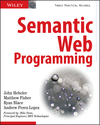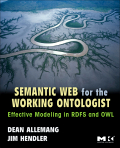 Semantic Web Programming by John Hebeler, Matthew Fisher, Ryan Blace, Andrew Perez-Lopez and, Mike Dean (Foreword) provides a thorough introduction to the most common Semantic Web standards, libraries and tools. The authors approach the Semantic Web from a developer's standpoint focusing on how to implement semantic functionality. A working example is built upon throughout the book. The example demonstrates many of the concepts and techniques discussed. The example application shows how data in multiple different formats and types of source systems can be linked together. In addition to discussing tools and libraries, a introduction to some of the most important semantic web standards is provided. These include the Resource Description Framework (RDF), RDF Schema (RDFS), and the Web Ontology Language (OWL). Despite the very ambitious amount of material that they attempt to cover, in my opinion the authors do a very good job in 600 pages of providing a good place to jump into Semantic Web programming.
Semantic Web Programming by John Hebeler, Matthew Fisher, Ryan Blace, Andrew Perez-Lopez and, Mike Dean (Foreword) provides a thorough introduction to the most common Semantic Web standards, libraries and tools. The authors approach the Semantic Web from a developer's standpoint focusing on how to implement semantic functionality. A working example is built upon throughout the book. The example demonstrates many of the concepts and techniques discussed. The example application shows how data in multiple different formats and types of source systems can be linked together. In addition to discussing tools and libraries, a introduction to some of the most important semantic web standards is provided. These include the Resource Description Framework (RDF), RDF Schema (RDFS), and the Web Ontology Language (OWL). Despite the very ambitious amount of material that they attempt to cover, in my opinion the authors do a very good job in 600 pages of providing a good place to jump into Semantic Web programming.While th
 e Semantic Web Programming text introduces the major semantic web standards, it doesn't delve too deeply into the creation of ontologies. This is where Semantic Web for the Working Ontologist - Effective Modeling in RDFS and OWL by Dean Allemang and James Hendler is really strong. The authors provide a comprehensive discussion of modeling in RDF, RDFS and OWL. Sections include practical advice on how to handle challenging modeling situations. Following the coverage of the standards two real world ontologies are discussed as examples of how modeling decisions impact the ontologies. Finally, good and bad modeling practices are presented. While the text covers the first version of OWL and OWL 2 became a W3C recommendation last fall, OWL 2 primarily adds to the language. As a result, this text remain very relevant.
e Semantic Web Programming text introduces the major semantic web standards, it doesn't delve too deeply into the creation of ontologies. This is where Semantic Web for the Working Ontologist - Effective Modeling in RDFS and OWL by Dean Allemang and James Hendler is really strong. The authors provide a comprehensive discussion of modeling in RDF, RDFS and OWL. Sections include practical advice on how to handle challenging modeling situations. Following the coverage of the standards two real world ontologies are discussed as examples of how modeling decisions impact the ontologies. Finally, good and bad modeling practices are presented. While the text covers the first version of OWL and OWL 2 became a W3C recommendation last fall, OWL 2 primarily adds to the language. As a result, this text remain very relevant.
